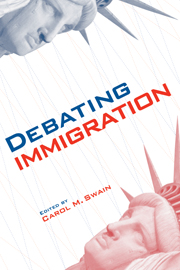Book contents
- Frontmatter
- Contents
- About the Contributors
- Preface
- Acknowledgments
- 1 Introduction
- PART I PHILOSOPHY AND RELIGION
- PART II LAW AND POLICY
- PART III ECONOMICS AND DEMOGRAPHICS
- 9 Borderline Madness
- 10 Immigrant Employment Gains and Native Losses, 2000–2004
- 11 Economics of Immigration and the Course of the Debate Since 1994
- 12 Immigration and Future Population Change in America
- PART IV RACE
- PART V COSMOPOLITANISM
- PART VI CONCLUSION
- Notes
- Index
9 - Borderline Madness
America's Counterproductive Immigration Policy
Published online by Cambridge University Press: 05 June 2012
- Frontmatter
- Contents
- About the Contributors
- Preface
- Acknowledgments
- 1 Introduction
- PART I PHILOSOPHY AND RELIGION
- PART II LAW AND POLICY
- PART III ECONOMICS AND DEMOGRAPHICS
- 9 Borderline Madness
- 10 Immigrant Employment Gains and Native Losses, 2000–2004
- 11 Economics of Immigration and the Course of the Debate Since 1994
- 12 Immigration and Future Population Change in America
- PART IV RACE
- PART V COSMOPOLITANISM
- PART VI CONCLUSION
- Notes
- Index
Summary
The year 1986 was pivotal for the political economy of North America. In that year, two events signaled the end of one era and the beginning of another. In Mexico, a new political elite succeeded in overcoming historical opposition within the ruling party and orchestrated the country's entry into the General Agreement on Tariffs and Trade. Then the Mexican president approached the United States to forge a new alliance that would create a free trade zone stretching from Central America to the North Pole. As U.S. officials worked jointly with Mexican authorities to integrate North America economically, however, they simultaneously and unilaterally acted to prevent the integration of its labor markets. Rather than incorporating the movement of workers into the new trade agreement, the United States insisted there would be no migration in North America, and to underscore its resolve Congress in 1986 passed the Immigration Reform and Control Act (IRCA).
Since then, the United States has pursued an escalating politics of contradiction, simultaneously moving toward integration while insisting on separation. Even as it moved headlong toward a consolidation of markets for capital, goods, commodities, services, and information, it somehow sought to keep labor markets separate. In the ensuing years, the U.S. government would spend increasing financial and human resources to demonstrate to the American public that the border was not porous with respect to migrants, even as it was becoming more permeable with respect to an increasing variety of flows.
- Type
- Chapter
- Information
- Debating Immigration , pp. 129 - 138Publisher: Cambridge University PressPrint publication year: 2007
- 8
- Cited by



